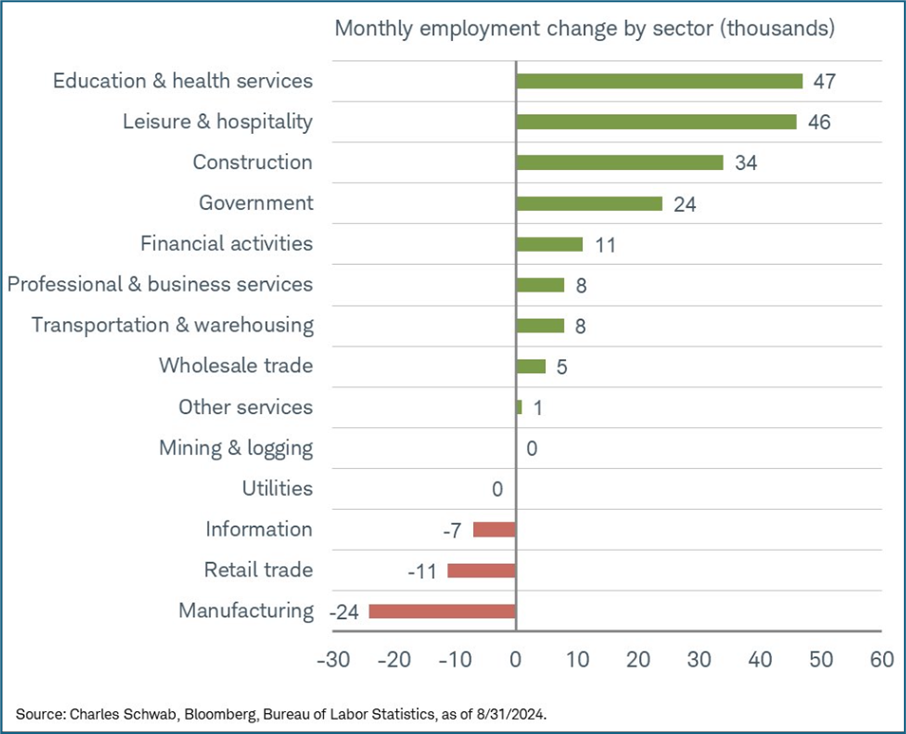August Jobs Report – A Modest Rebound Signals a 25bps Rate Cut
August Jobs Report – A Modest Rebound Signals a 25bps Rate Cut
- Modest improvement in the labor market from July’s disappointment, seems to argue for a 25bps rate cut later this month. August nonfarm payroll gains were 142 thousand vs. 165 thousand expected and 89 thousand in July (revised down from an initial 114 thousand). June was revised lower by 61 thousand jobs, bringing the two-month revisions to 86 thousand continuing a year-long trend of downward revisions. Recall, the just finished annual benchmarking removed 818 thousand reported jobs from the March 2023 – March 2024 period. Meanwhile, private sector jobs increased 118 thousand vs. 140 thousand expected and 74 thousand in July (revised down from an initial 97 thousand).
- For a second month in a row, the Household Survey (which generates the unemployment rate, labor force participation, etc.) reported a similar picture as the Establishment Survey. For August, the Household Survey reported an increase of 168 thousand jobs and a decrease of 48 thousand in the ranks of the unemployed. With both surveys posting similar results, it does give one a little more comfort in the validity of the numbers. That said, the ongoing downward revisions in the Establishment Survey’s job gains speaks to the slowing labor market momentum.
- Job gains were strongest in the usual suspects: leisure/hospitality (46k), healthcare/social assistance (44k), construction (34k), and government (24k). Job losses occurred in durable goods manufacturing (-25k), retail trade (-11k), and for a fifth straight month temporary help services shed jobs, this time 3 thousand. This continuing trend signals softening in demand with firms reducing temp help first before moving to cut full-time workers, however, this month’s cuts were slight. The job loss categories also highlight the weakness in the manufacturing side vs. services side of the economy.
- The unemployment rate fell a tenth to 4.2% (4.22% unrounded), matching expectations. The Household Survey reported a decrease of 48 thousand in the ranks of the unemployed but also an increase of 120 thousand in the labor force. Previous months saw larger increases in the labor force, helped by large immigration gains, and the reduced hiring of these new potential workers boosted the unemployment rate. While increases in the unemployed stemming from a growing labor force are less problematic to policymakers, the number of unemployed persons has increased 775 thousand over the last year.
- Average Hourly Earnings rose 0.4%, beating the 0.3% expectation and better than the 0.2% gain in July. The year-over-year pace increased to 3.8%, beating the 3.7% expectation and up from 3.6% in July. Average weekly hours increased a tenth to 34.3 hours from 34.2 hours, matching expectations. Weekly hours peaked at 35.0 a year ago and seem to be settling in the low 34-hour range, another sign of moderating labor demand. The pick-up in both wages and hours work speaks to the resilience of the labor market, despite the slowing momentum.
- Despite the slight increase in the labor force, the Labor Force Participation Rate remained at 62.7%, matching expectations. The participation rate a decade prior to the pandemic ranged between 62.5% and 63.0% while the average over the past year has been 62.6%. The prime age (25-54yr old) group saw the participation rate remain the highest at 83.9% vs. 84.0% in July. The participation rate of this cohort remains near the highest in 24 years (see graph below). The somewhat stalled nature of the overall participation rate is more a function of the older cohort (>55yrs) leaving the labor force in increasingly larger numbers. Thanks Boomer.
- After the July employment report noted further loss of momentum, August’s report was a bit firmer, easing fears slightly that the labor market was slowing faster than coming Fed rate cuts could slow. Wage gains improved in August but remain below year-ago levels that were inflation-inducing. Temporary help job losses continued for a fifth straight month, and while hours worked ticked higher by a tenth, they remain below year ago levels, indicating employers are reducing temp help and limiting hours before increasing layoffs. The memories of labor shortfalls coming out of the lockdowns remain vivid. The modest improvement in August, and despite downward revisions to July and June, probably quash the case for a 50bps in September. We expect, at this point, it will be 25bps. If inflation continues to cooperate, the quarterly cuts could become an every-meeting event rather than quarter-end meetings.
- In another sign of reluctance to laying off fulltime workers, initial jobless claims from yesterday remained muted. Claims for the week ended August 31 were 227 thousand, below the 230 thousand forecast and 231 thousand the prior week. Continuing claims fell too from 1.868 thousand to 1.838 thousand, below the 1.867 forecast. The next step in labor market weakness will be increasing layoffs and we’re just not seeing that in claims figures yet. That’s another argument for a 25bps cut rather than 50.
- Finally, the August ISM Services Index was released yesterday, and it too relieved concerns about a weakening labor market. The largest and healthiest part of the economy remained so in August as the headline reading was 51.5 vs. 51.3 expected and 51.4 in July. And while the employment metric softened from 51.1 to 50.2, it remained in expansion territory, albeit barely. In addition, the new orders metric rose from July’s 52.4 to 53.0. So, while the manufacturing sector remains in the doldrums, the much larger services sector continues to be doing ok, and that too argues for 25bps vs. 50bps.

Securities offered through the SouthState | DuncanWilliams 1) are not FDIC insured, 2) not guaranteed by any bank, and 3) may lose value including a possible loss of principal invested. SouthState | DuncanWilliams does not provide legal or tax advice. Recipients should consult with their own legal or tax professionals prior to making any decision with a legal or tax consequence. The information contained in the summary was obtained from various sources that SouthState | DuncanWilliams believes to be reliable, but we do not guarantee its accuracy or completeness. The information contained in the summary speaks only to the dates shown and is subject to change with notice. This summary is for informational purposes only and is not intended to provide a recommendation with respect to any security. In addition, this summary does not take into account the financial position or investment objectives of any specific investor. This is not an offer to sell or buy any securities product, nor should it be construed as investment advice or investment recommendations.
